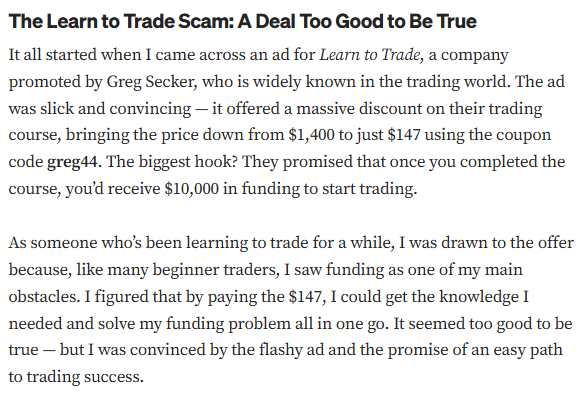Introduction: The Allure of a Trading Guru
In the fast-paced world of forex trading, where promises of wealth captivate aspiring investors, Greg Secker emerges as a charismatic figurehead. Through his companies—Learn to Trade, SmartCharts, and others—he markets himself as a master trader who rose from humble beginnings to multi-millionaire status by his twenties. His seminars, online courses, and trading platforms, adorned with claims of empowering over 400,000 traders worldwide, draw in novices with visions of financial independence. Yet, a darker narrative lurks beneath this polished image. Our comprehensive investigation into Greg Secker’s operations uncovers a troubling pattern of risk factors, red flags, adverse news, negative reviews, and allegations that paint a portrait of potential deception. From questionable credentials to accusations of high-pressure sales and financial losses, this risk assessment and consumer alert delve into the shadows of Secker’s empire, urging caution for those tempted by his promises.

Background: Greg Secker’s Rise to Prominence
The Self-Proclaimed Master Trader
Greg Secker’s story is one of calculated allure. Born in England, he claims to have transitioned from an IT role at Thomas Cook Financial Services to a forex trading prodigy, becoming a vice president at Mellon Financial Corporation by age 25. By 27, he purportedly retired to build a trading floor in his home, founding Learn to Trade in 2003. His ventures now include SmartCharts, a trading software platform, and the Greg Secker Foundation, a philanthropy effort focused on rebuilding communities in the Philippines. Secker’s narrative—shared through YouTube ads, seminars, and his book Financial Freedom Through Forex—positions him as a mentor dedicated to democratizing wealth.
The Business Empire
Learn to Trade operates globally, offering courses, webinars, and coaching priced from hundreds to thousands of dollars. SmartCharts, launched as a technical analysis tool, promises AI-driven insights for traders, with subscriptions costing up to $1,999 annually. Secker’s companies claim to have trained over 400,000 individuals, with testimonials praising his passion and expertise. Yet, the absence of verifiable trading records and persistent allegations cast doubt on the legitimacy of his success story.
Risk Factors: Structural Flaws in Secker’s Operations
Lack of Regulatory Oversight
A critical risk factor is the absence of regulatory credentials for Secker’s companies. Learn to Trade and SmartCharts operate in speculative markets like forex, where oversight is paramount. Unlike regulated brokers, these entities are not licensed by bodies like the UK’s Financial Conduct Authority (FCA) or Australia’s ASIC for trading activities. SmartCharts Ltd., registered in Malta, lacks transparency about its regulatory status, raising concerns about client fund protection.
High-Risk Trading Models
Secker’s platforms promote forex trading with high leverage, often 1:100 or more, which amplifies both gains and losses. Forex trading, as Secker himself notes, carries significant risk, with studies suggesting over 70% of retail traders lose money. His courses and tools, while marketed as risk-mitigating, cannot guarantee profits, yet promotional materials emphasize wealth over caution, potentially misleading novices.
Expensive Products and Services
Courses at Learn to Trade range from $147 webinars to $3,000+ coaching packages, while SmartCharts subscriptions cost $1,999 yearly. Critics argue these prices are exorbitant for educational content, especially without proven efficacy. The high cost, coupled with promises of quick riches, targets vulnerable individuals, amplifying financial risk if trading fails.
Red Flags: Indicators of Potential Misconduct
Unverified Trading Success
A glaring red flag is Secker’s lack of documented trading performance. Despite claiming to be a “master trader,” no public records validate his personal trading profits. Reports suggest his wealth stems not from trading but from course sales and seminars, undermining his credibility as a mentor. One source labels him a “fake artist” for this discrepancy, highlighting the absence of evidence supporting his trading prowess.
Affiliations with Questionable Entities
Secker’s companies share ties with Capital Index, a brokerage he co-founded, creating a potential conflict of interest. Learn to Trade directs clients to trade through Capital Index, which critics allege benefits Secker financially when clients lose money—a common issue with dealing desk brokers. This affiliation raises questions about impartiality, as educational platforms should remain independent of trading firms.
Aggressive Marketing Tactics
Secker’s advertising, featuring Rolls Royces and luxury lifestyles, borders on predatory. YouTube ads with license plates reading “PRO5PER” and promises of financial freedom target impressionable audiences. Critics argue these tactics oversimplify trading’s risks, luring clients into costly courses with unrealistic expectations. Such marketing, while not illegal, skirts ethical boundaries by prioritizing hype over honesty.

Adverse News: Media Scrutiny and Public Backlash
Bloomberg Investigation
In December 2024, Bloomberg reported that Learn to Trade faced complaints serious enough to prompt YouTube to remove its main channel earlier that year. The article highlighted client dissatisfaction and regulatory concerns, though Secker denied wrongdoing, claiming no intent to mislead customers. This adverse publicity underscores growing skepticism about his operations.
UK Media Coverage
A 2022 Telegraph article detailed a consumer’s struggle to secure a £3,000 refund from Learn to Trade after canceling a seminar within the cooling-off period. The reader felt “ripped off,” accusing Secker of selling a dream that failed to deliver. Such reports suggest systemic issues in customer service and refund policies, eroding trust in Secker’s brand.
Online Forums and Discussions
Quora and other platforms host debates about Secker’s integrity, with users questioning whether his techniques are fraudulent. While not conclusive, these discussions reflect public unease, amplified by reports of suppressed negative feedback, such as deleted comments on Secker’s social media. This pattern of controlling the narrative hints at an effort to obscure criticism.
Negative Reviews: Voices of Disillusionment
Consumer Complaints
Negative reviews paint a grim picture of Secker’s offerings. On platforms like Trustpilot and Medium, clients report financial losses and unmet expectations. One user described losing money after enrolling in a $147 Learn to Trade course, lured by a discounted offer that led to high-pressure upsells. Another called the content “generic,” arguing it failed to justify its cost. These reviews suggest a gap between Secker’s promises and reality.
Allegations of High-Pressure Sales
Multiple reviews accuse Learn to Trade of aggressive sales tactics. Clients report being pushed into expensive coaching packages after free webinars, with representatives emphasizing urgency to secure deposits. One complainant noted feeling manipulated into spending beyond their means, only to find the training repetitive and unhelpful. Such tactics risk exploiting vulnerable individuals seeking financial stability.
Platform and Software Issues
SmartCharts users have criticized its functionality, with some calling it overpriced at $1,999 annually. Reviews on ForexRobotNation warn that the platform’s “scanner” tool, touted as a million-dollar innovation, underperforms compared to free alternatives. Clients also report technical glitches and inadequate support, further undermining Secker’s claims of cutting-edge technology.
Allegations: Serious Accusations of Misconduct
Scam Allegations
The most damning allegations label Secker a scammer. A 2024 Medium post titled “How I Got Scammed by Learn to Trade (Greg Secker)” details a client’s experience of being misled by slick ads and losing money on a discounted course. The author accuses Secker of prioritizing profits over education, a sentiment echoed on gripeo.com, which claims he misleads traders through multiple websites. While Secker denies these claims, their consistency raises concerns.
Misrepresentation of Expertise
Critics allege Secker exaggerates his trading credentials. Net Factual’s 2025 fact-check questions his status as a trader, citing reports that his wealth derives from course sales, not forex profits. The absence of trading records fuels speculation that Secker is more marketer than mentor, a charge that undermines his entire business model.
Potential Referral Schemes
Allegations suggest Learn to Trade operates a referral scheme with Capital Index, encouraging clients to trade through a broker Secker controls. This setup, if true, could incentivize steering clients toward risky trades to generate commissions, a practice critics call unethical. While unproven, the affiliation between Secker’s companies warrants scrutiny.

Consumer Impact: The Human Cost
Financial Losses
The financial toll on Secker’s clients is significant. Negative reviews cite losses ranging from course fees to trading capital, with some attributing their setbacks to inadequate training. One client reported spending $3,000 on coaching, only to lose thousands more trading with Capital Index, feeling misled by Secker’s promises. These stories highlight the real-world consequences of his high-cost, high-risk model.
Emotional and Psychological Harm
Beyond money, clients describe emotional devastation—shame, frustration, and eroded confidence. Aspiring traders, drawn by Secker’s vision of empowerment, often emerge disillusioned, blaming themselves for failures that may stem from overhyped promises. The psychological impact of financial loss, coupled with aggressive sales pressure, amplifies the harm for vulnerable individuals.
Barriers to Recourse
Victims face steep barriers to recovery. Refunds from Learn to Trade are reportedly hard-won, with complaints about unresponsive customer service. Legal action is daunting due to Secker’s companies operating across jurisdictions like the UK, Malta, and the Philippines. Without regulatory oversight, clients have little leverage, leaving many to absorb their losses in silence.
Systemic Implications: A Broader Threat
Erosion of Trust in Forex Education
Secker’s alleged misconduct risks tarnishing the forex education industry. By prioritizing sales over substance, he fuels skepticism about legitimate training providers, deterring cautious investors from pursuing financial literacy. This erosion of trust stifles innovation and growth in a sector already fraught with volatility.
Exploitation of Vulnerable Populations
Secker’s marketing targets novices, retirees, and those seeking quick financial fixes—groups prone to exploitation. His ads, emphasizing luxury and independence, exploit economic anxieties, drawing parallels to predatory schemes that thrive on desperation. This pattern underscores the need for stricter oversight of financial education platforms.
Regulatory Gaps
Secker’s ability to operate without licenses exposes flaws in global regulation. Forex education, unlike brokerages, often falls into a gray area, allowing figures like Secker to evade scrutiny. His Malta-based SmartCharts and UK-based Learn to Trade exploit jurisdictional gaps, highlighting the urgency of harmonized laws to protect consumers.
Consumer Alert: Protecting Yourself
Verify Credentials
Before enrolling in Secker’s programs, demand proof of his trading success and regulatory status. Legitimate mentors provide transparent records and operate under oversight. Absence of these is a red flag—proceed with extreme caution.
Research Independently
Rely on third-party reviews from platforms like Trustpilot or Bloomberg, not Secker’s curated testimonials. Search for complaints and legal issues, using keywords like “Greg Secker scam” to uncover hidden risks. Cross-reference claims against reputable sources to avoid falling for polished marketing.
Avoid High-Pressure Sales
Be wary of urgency tactics pushing you to buy courses or software. Legitimate providers allow time for informed decisions. If pressured, walk away—high costs and high risks demand careful consideration.
Start Small and Diversify
If exploring forex, start with free or low-cost resources from regulated platforms. Never invest more than you can afford to lose, and diversify your financial strategy to avoid over-reliance on trading. Secker’s promises of quick wealth are outliers, not norms.
Conclusion: A Call for Accountability
Greg Secker’s trading empire, built on charisma and bold claims, crumbles under scrutiny. Risk factors like unregulated operations, red flags such as unverified success, and allegations of scams reveal a troubling pattern that endangers consumers. Negative reviews and adverse news amplify the voices of those burned by his costly courses and software, while systemic gaps allow his ventures to persist unchecked. This risk assessment is a clarion call: investors deserve transparency, not exploitation. Regulators must close loopholes, and consumers must arm themselves with skepticism. Until Secker provides concrete proof of his claims, his empire remains a gamble not worth taking. Protect your finances—steer clear of the mirage.











